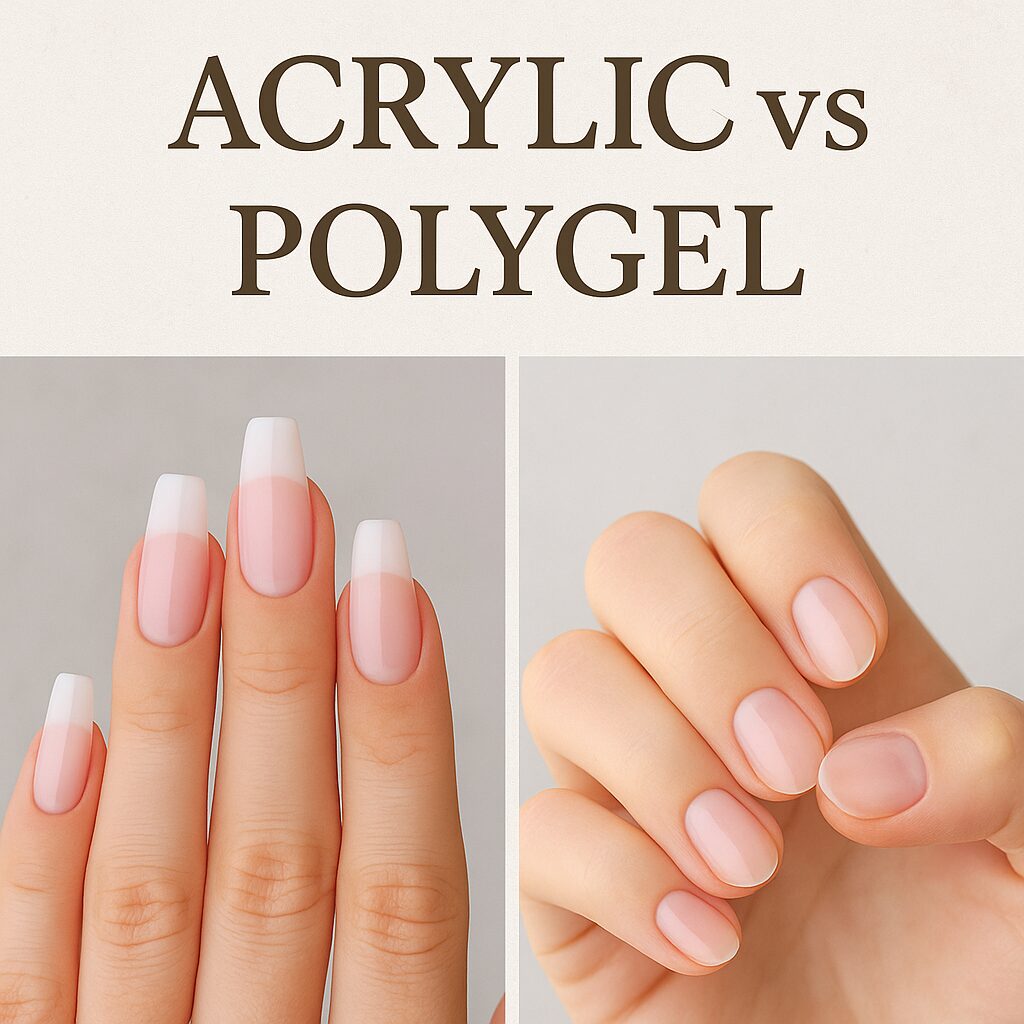
Understanding Acrylic vs Polygel is the key to choosing the perfect system for your lifestyle and nail goals — whether you want ultra-strong extensions or natural-looking overlays.
At first glance, they might seem similar — both give you strong, durable nails that can be shaped and styled beautifully. But when it comes to feel, flexibility, and nail health, they’re worlds apart.
Let’s dive into the differences, pros, and cons to help you decide which one’s right for you.
💅 What Are Acrylic Nails?
Acrylic nails are one of the most classic and widely used nail enhancement systems — known for their unmatched strength and durability. They’ve been around for decades and are still a salon staple for those who love long, sculpted nails.
How They Work:
These nails are made by combining a liquid monomer and a powder polymer. When mixed, they form a moldable paste that hardens into a solid layer when exposed to air — no UV or LED lamp required.
Once hardened, acrylics become strong, protective extensions that can be filed, shaped, and painted just like natural nails.
Pros of Acrylic Nails:
✅ Extremely strong and durable — perfect for long nails.
✅ Don’t need curing under a lamp.
✅ Hold their shape well, even for dramatic styles (stiletto, coffin, almond).
✅ Long-lasting — typically 3–4 weeks before infills are needed.
Cons of Acrylic Nails:
❌ Strong odor during application due to monomer liquid.
❌ Can feel thick or heavy on natural nails.
❌ Removal requires soaking and filing, which can weaken nails if not done gently.
💡 Tip: Acrylic nails are best for those who prioritize durability over comfort — perfect for long nail lovers or those who use their hands frequently.
💎 What Is Polygel?
Polygel is a newer innovation in the nail industry — a hybrid formula that combines the strength of acrylic with the flexibility of gel. It was designed to be easier to apply, lighter to wear, and gentler on natural nails.
How It Works:
Polygel comes in a ready-made tube or pot — no mixing needed. You squeeze out the gel, apply it to the nail or nail form, and shape it using a spatula and brush dipped in slip solution. Once you’re happy with the shape, you cure it under a UV or LED lamp to harden.
Why it’s a game changer: It’s odorless, lighter, and easier to control, making it perfect for beginners or anyone sensitive to chemical smells.
Pros of Polygel:
✅ Lightweight and natural-feeling.
✅ Odor-free and mess-free (no monomer mixing).
✅ Flexible — less prone to cracking than acrylic.
✅ Easy to file, shape, and maintain.
Cons of Polygel:
❌ Requires a curing lamp.
❌ Slightly less rigid than acrylic.
❌ Needs proper curing — otherwise can lift early.
💅 Fun fact: The Polygel system was first introduced by Gelish, and was designed to give nail artists “the perfect balance between acrylic and hard gel” — strength, flexibility, and ease all in one.
⚖️ Acrylic vs Polygel — What’s the Difference?
At their core, both systems give you long-lasting, sculpted nails. But the difference lies in how they’re applied, how they feel, and how they’re removed.
| Feature | Acrylic Nails | Polygel Nails |
|---|---|---|
| Formula | Liquid monomer + powder polymer | Pre-mixed gel hybrid |
| Application | Air-dried (no lamp) | Cured under LED/UV lamp |
| Smell | Strong monomer odor | Odorless |
| Texture | Thick and rigid | Soft and flexible |
| Durability | 3–4 weeks | 2–3 weeks |
| Weight | Heavier | Lighter and natural-feeling |
| Skill Level | Professional | Beginner-friendly |
| Removal | Soak-off with acetone + filing | File-off or soak-off (brand-dependent) |
| Maintenance | Requires professional fills | Easier to maintain at home |
Bottom line: Acrylic nails are stronger and longer-lasting, while Polygel nails are lighter, easier, and more comfortable for everyday wear.
⏱️ Which One Lasts Longer?
If your priority is maximum durability, acrylic nails take the win. They can last up to four weeks before needing a refill and hold up well even with heavy use.
Polygel nails usually last two to three weeks, but their flexibility makes them less likely to snap or crack. For everyday activities, Polygel’s “bend without break” texture is more forgiving than acrylic’s rigid surface.
💡 Tip: Whichever you choose, good prep and aftercare are key. Always clean, buff, and dehydrate the nail before application — and avoid soaking your nails in hot water right after curing.
🌿 Which One Is Healthier for Natural Nails?
Both systems can be safe and non-damaging — if applied and removed correctly.
However, Polygel is considered gentler overall. It doesn’t use harsh monomer liquids or release strong fumes, making it safer for sensitive nails or at-home users.
Acrylic nails, on the other hand, involve stronger chemicals and more aggressive filing during removal. Over time, that can dry out or thin the natural nail plate if not done professionally.
Pro Tip: Always give your nails a break every few months and apply a strengthening treatment.
🧴 Which One Is Easier to Apply?
Here’s where Polygel shines.
- Acrylics require precise timing and speed — the product hardens quickly as it reacts with air. Once it starts setting, there’s no going back.
- Polygel, however, stays workable until cured under the lamp. You can take your time shaping it perfectly, making it great for beginners or detailed designs.
Many nail techs love Polygel because it’s smoother to file and creates less dust compared to acrylic.
💅 At-home bonus: With a small starter kit and a UV/LED lamp, Polygel nails are achievable for DIY enthusiasts without the salon smell or stress.
💧 Which One Is Easier to Remove?
Acrylic: Requires soaking in acetone for 20–30 minutes, followed by gentle filing.
Polygel: Depends on the formula — many can be soaked off like gel polish, while others need a light file-down.
Both systems should never be peeled or pried off, as that can lift natural nail layers. Always follow the proper removal process to prevent damage.
Quick Tip: After removal, use cuticle oil or a nail repair treatment to restore hydration and shine.
💬 Which One Should You Choose?
The right choice depends on your nail goals, skill level, and lifestyle.
Choose Acrylic if you:
- Want extra-long or sculpted nails.
- Don’t mind a salon visit for maintenance.
- Prefer a super-strong, rigid feel.
Choose Polygel if you:
- Want lightweight, flexible, and natural nails.
- Prefer an odor-free, low-fume option.
- Like doing your nails at home.
For many nail lovers, Polygel is the modern upgrade — offering strength with comfort. But if you love drama, length, and ultra-tough nails, Acrylic still reigns supreme.
🧠 Expert Tips for Perfect Results
- Always clean and dehydrate nails before applying any enhancement.
- Apply thin, even layers — too thick causes lifting.
- Cure Polygel fully under an LED/UV lamp (no skipping seconds!).
- Seal the nail’s free edge for long-lasting wear.
- Moisturize cuticles daily to prevent dryness.
- Use gloves for cleaning or washing dishes to protect your manicure.
🙋♀️ FAQs
Q1: Which is stronger, Acrylic or Polygel?
Acrylic is stronger overall, but Polygel is more flexible and resistant to cracks.
Q2: Can you infill Polygel like Acrylic?
Yes, both can be infilled every 2–3 weeks to extend wear.
Q3: Does Polygel damage nails?
No — not if applied and removed properly. It’s actually gentler than acrylic.
Q4: Can I use regular polish on Polygel or Acrylic nails?
Yes! You can paint, design, or add chrome — just finish with a top coat.
Q5: Which looks more natural?
Polygel nails typically have a thinner, softer, and more natural appearance.
